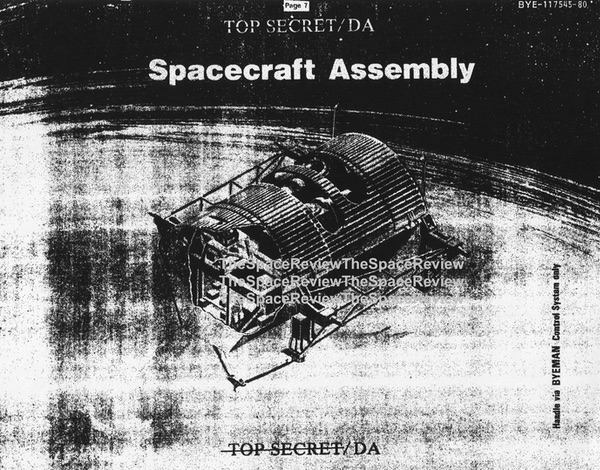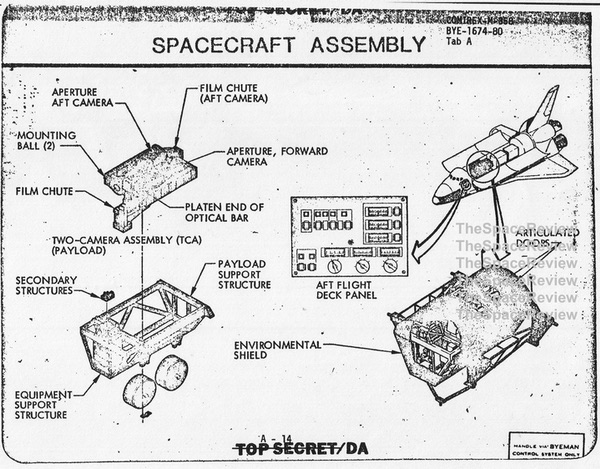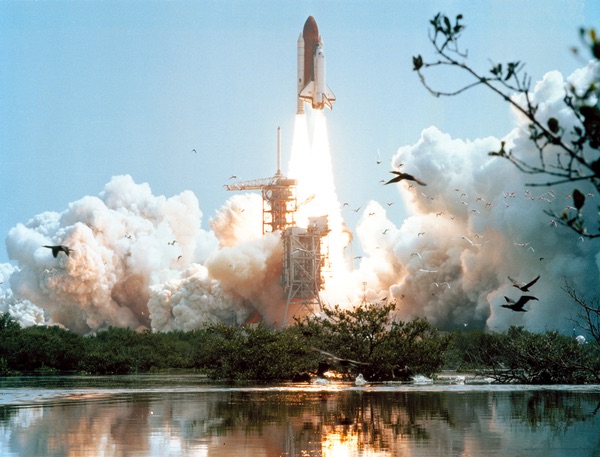Top Secret DAMON: the classified reconnaissance payload planned for the fourth space shuttle missionby Dwayne A. Day
|
| DAMON began as the ZEUS/PATHFINDER program, an evolution of the ZEUS program to put optical systems onboard NASA’s space shuttle to replace the venerable HEXAGON satellites that photographed vast swaths of the Soviet Union in medium resolution. |
Information about DAMON has never been released before. DAMON was scheduled to launch aboard the space shuttle Columbia in the second quarter of 1982, initially on the sixth shuttle flight. But as the shuttle program kept slipping, DAMON was re-manifested to fly on the fourth and final test flight, known as Orbital Flight Test-4. The STS-4 mission eventually launched in June 1982, with Thomas K. Mattingly and Henry W. Hartsfield Jr. as crew, but DAMON was not aboard, and neither was the third astronaut who most likely would have ridden along to operate it. The project was canceled after hardware was built and the NRO was gearing up for its first use of the Space Shuttle.
DAMON began as the ZEUS/PATHFINDER program, an evolution of the ZEUS program to put optical systems onboard NASA’s space shuttle to replace the venerable HEXAGON satellites that photographed vast swaths of the Soviet Union in medium resolution. (See “Black ZEUS: The top secret shuttle mission that never flew,” The Space Review, January 30, 2017 and “Black ops and the shuttle (part 2), Reconnaissance missions in the space shuttle, from WASP to ZEUS,” The Space Review, August 7, 2017) By October 1979, ZEUS/PATHFINDER had progressed to the point where the NRO was ready to fly an initial payload. Various camera systems had been evaluated, but the NRO ultimately decided upon an inexpensive and conservative approach, using existing camera hardware from the HEXAGON reconnaissance satellite mounted on a pallet in the shuttle payload bay.
 |
Because ZEUS was now going to fly, the NRO had to change its code-word for security purposes. Three code-words were evaluated and the leading candidate was WATCHMAN. However, due to proposed changes in how the US intelligence community classified intelligence programs, WATCHMAN was rejected because it implied a reconnaissance mission. Instead, the NRO selected DAMON. Although it is not entirely clear why the name was selected, one NRO official, apparently a fan of classical literature, noted that it was associated with the story of Damon and Pythias, which illustrated the ideal of friendship. One of the goals of DAMON was to demonstrate that the NRO and NASA could cooperate on launching and operating intelligence satellites and shuttle payloads. Another major goal was demonstrating the suitability of the shuttle for operating complex intelligence payloads in terms of stability and precise pointing toward the ground.
By early 1980, DAMON was an approved program with Lockheed selected as the prime contractor and camera manufacturer Perkin-Elmer as a major subcontractor. But members of Congress who knew about the secretive program were wary. They ordered that DAMON only be approved as an experimental program, the “DAMON Metric Experiment.” The NRO initially planned for two flights of DAMON, in spring 1982 and again in spring 1983, but Congress ordered that only one flight was approved.
| Although existing documents only provide part of the story, there is evidence that DAMON was part of a multi-party struggle then underway between different parts of the NRO as well as members and staff of the House Permanent Select Committee on Intelligence. |
DAMON progressed during the first few months of 1980, with contractors signed and beginning work. A major effort was developing the pallet that would secure the camera system and associated hardware inside the shuttle payload bay. This was the key piece of entirely new hardware for the mission. For the first flight DAMON would fly alone, but if it eventually became an operational system, it would ride with other payloads, possibly including deployable satellites, in the shuttle’s large payload bay.
But by spring of 1980 DAMON ran into opposition. A key congressional committee refused to approve further funding for DAMON. It was already funded through the rest of 1980, and could continue until the ongoing budget process was concluded later in the year, as its advocates tried to convince members of Congress to approve it. But the withdrawal of approval for further funding was a major warning sign that the program was in jeopardy.
Although existing documents only provide part of the story, there is evidence that DAMON was part of a multi-party struggle then underway between different parts of the NRO as well as members and staff of the House Permanent Select Committee on Intelligence. In the latter 1970s, Martin Faga was a staff member on the HPSCI, where one of his responsibilities was keeping track of NRO developments. Many years later Faga became head of the National Reconnaissance Office. In an interview conducted by the NRO historian in the 1990s, Faga was asked about the 1978 decision to put all future NRO payloads on the space shuttle. “We were uncomfortable with it,” Faga replied. “The decision really had been, to move that way, had largely been made even by the time the [HPSCI] committee started operations in late ’77. I recall that there was an idea that came along ’78, ’79, maybe ’80, of flying all of our area search missions using film cameras on shuttle missions. That would have had to be four to six missions a year of 21 days each. We thought that was crazy, and fought it off,” Faga said.
ZEUS/PATHFINDER had been scaled down in part as a result of HPSCI opposition. That opposition continued into 1980, even though DAMON had been initially approved. Most likely what happened was that other people both in the CIA and NRO, and possibly also including intelligence contractors, argued against DAMON throughout 1980, gradually convincing others that DAMON was a waste of money and was unnecessary to demonstrate that NRO and NASA could work together, or that the shuttle was useful as a reconnaissance platform.
 |
A trove of newly declassified documents about DAMON includes more than a dozen position papers justifying DAMON’s existence. The justifications changed subtly from document to document, but their large number indicates that program managers were fighting to demonstrate why DAMON was needed. DAMON was not an operational mission, although part of the justification was that it could serve as a gap-filler or backup to the few remaining HEXAGON missions, producing about one quarter as much imagery as a single HEXAGON mission. DAMON was also somewhat vaguely justified in terms of helping to fill an anticipated gap in medium-resolution satellite imagery in the 1985–1990 time period.
| The NRO found other methods of gaining medium resolution imagery and planned to retire the HEXAGON by the mid-1980s. DAMON was soon all but forgotten. |
The DAMON mission would have launched into orbit from Cape Canaveral, and it is possible that a payload specialist would have flown on board. Although planning documents indicate that the mission was planned for a 57-degree orbit, at least one document states that in order to accommodate the payload mass, NASA would have flown in a lower inclination orbit. STS-4 ultimately flew in a 28.5-degree orbit.
But by the end of December 1980, the budget was finalized and DAMON was canceled. A security officer at the NRO warned that it was important that personnel not interpret cancellation as declassification. DAMON’s connection to the HEXAGON program could result in classified information on that still-active program leaking. The pallet developed for DAMON could be used for the Cryogenic Infrared Radiance Instrumentation for Shuttle (CIRRIS) experiment. But the NRO needed a cover story in case anybody asked how come equipment that normally would take several years to develop was produced in a much shorter period of time. The NRO found other methods of gaining medium resolution imagery and planned to retire the HEXAGON by the mid-1980s. DAMON was soon all but forgotten.
Note: we are temporarily moderating all comments subcommitted to deal with a surge in spam.
